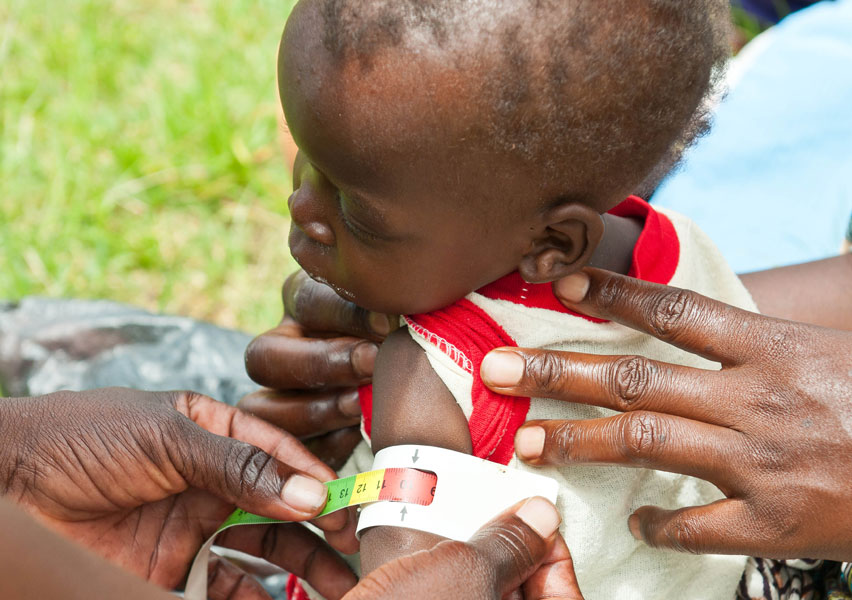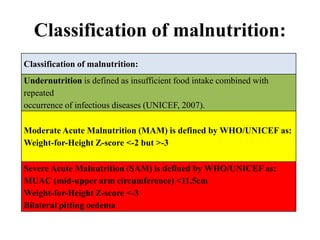Malnourished Definition Unicef
Malnutrition refers to deficiencies or excesses in nutrient intake imbalance of essential nutrients or impaired nutrient utilization. RUSF is intended to be eaten directly from the package with no dilution mixing or cooking.

Reduce Stunting Unicef Eastern And Southern Africa
Always feeling cold.

Malnourished definition unicef. They are also more resilient in the face of crisis. According to the World Health Organization malnutrition refers to deficiencies or excesses in nutrient intake imbalance of essential nutrients or impaired nutrient utilization. Malnutrition is a category of diseases that includes undernutrition and overnutrition.
Adults who were undernourished as children are at risk of developing diseases. A lack of appetite or interest in food or drink. Malnourished children may be short for their age thin or bloated listless and have weakened immune systems.
Well-nourished children are better able to grow learn play and participate in their communities. Wasting - Wasting in children is a symptom of acute undernutrition usually as a consequence of insufficient food intake or a high incidence of infectious diseases especially diarrhoea. Children with primary acute malnutrition are common in developing countries as a result of inadequate food supply caused by social economic and environmental factors.
Percentage of Children Under the Age of Five who are Malnourished Egypt 20142 Source. WHO Definition Of Malnutrition. Disease-related malnutrition arises due to reduced dietary intake malabsorption increased nutrient losses or altered metabolic demands.
In Egypt despite the investment in the health sector and a notable decline in child mortality malnutrition. Some signs and symptoms of malnutrition include. Undernutrition manifests in four broad forms.
Malnutrition occurs when an individual gets too few or too many nutrients resulting in health problems. In the short term we work to address immediate needs to avoid a deterioration of the situation and prevent mortality in young children by supporting early detection and care for children suffering from severe acute malnutrition and providing ready-to-use therapeutic food for their treatmentWe also provide access to water. UNICEF - EAPRO - 2016 Technical briefing note MUAC cut-off to define acute malnutrition among pregnant and nursing women What is the current state of knowledge what evidence exist and what is the current practice in the field.
Malnutrition is a common under-recognised and undertreated condition in hospital patients. Malnutrition also leads to poor school performance which can result in future income reduction. One is undernutritionwhich includes stunting low height for age wasting low weight for height underweight low weight for age and micronutrient deficiencies or.
The double burden of malnutrition consists of both undernutrition and overweight and obesity as well as diet-related noncommunicable diseases. Malnutrition refers to deficiencies excesses or imbalances in a persons intake of energy andor nutrients. Secondary acute malnutrition is usually due to an underlying disease.
An inability to concentrate. Malnutrition in children is especially harmful. Risk Factors and Causes of Undernutrition.
By focusing on these first 1000 days UNICEF has helped cut the number of children under 5 who are stunted by 55 million since 2000. In turn wasting impairs the functioning of the immune system and can lead to increased severity and duration of and susceptibility to infectious diseases. Nutritional disorders can affect any system in the body and the senses of sight taste and smell.
Egypt Demographic and Health Survey. They may also produce anxiety changes in mood and other psychiatric symptoms. UNICEF-WHO-WB Joint Child Malnutrition Estimates inter-agency group regularly updates the global and regional estimates in prevalence and numbers for each indicator.
Acute malnutrition is a nutritional deficiency resulting from either inadequate energy or protein intake. All publicly available MICS and DHS with anthropometric data for the full age range of 0 to 59 months have been reanalyzed to produce standardized estimates over time. The damage to physical and cognitive development during the first two years of a childs life is largely irreversible.
Ready-to-use Supplementary Food RUSF is a food supplement intended to be used as part of a nutritional program to treat moderate acute malnutrition MAM for children over 6 months for a period of 2-3 months. The term malnutrition covers 2 broad groups of conditions. Stunting in the first 1000 days is associated with poorer performance in school both because malnutrition affects brain development and also because malnourished children are more likely to get sick and miss school.
UNICEF purchases 80 percent of the worlds supply of Ready-To-Use Therapeutic Food a miracle treatment formulated to bring children who are suffering from severe acute malnutrition back from the brink of death. Wide-ranging changes in physiological function occur in malnourished patients leading to increased rates of. Wasting is the most immediate visible and life-threatening form of malnutrition.
UNICEF WHO World Banks Joint global database on child malnutrition provides country-level trends of 4 core child malnutrition indicators. Yet today many children are not getting the nutrition they need to survive and thrive. Malnutrition can cause permanent widespread damage to a childs growth development and well-being.
UNICEF Egypt Data Snapshot - Issue 1 October 2018 2 WHAT ARE THE MALNUTRITION TRENDS IN EGYPT. UNICEF works to prevent and treat malnutrition. It results from the failure to prevent malnutrition among the most vulnerable children.
There is no internationally agreed recommended or accepted MUAC cut-off and thresholds to estimate or classify. The key findings 2021 Edition includes global and regional trends and for the first time country-level estimates are also presented with a summary of the enhanced methodology. Good nutrition is the bedrock of child survival and development.
Undernutrition is a lack of nutrients. Specifically it is a deficiency excess or imbalance of energy protein and other nutrients which adversely affects the bodys tissues and form. The double burden of malnutrition consists of both undernutrition and overweight and obesity as well as diet-related non-communicable.
Undernutrition results from the complex interplay of a range of distal and proximal factors as illustrated by the United Nations Childrens Funds UNICEF conceptual framework for undernutrition figure 111 UNICEF 2013The framework defines basic underlying and immediate causes of undernutrition and demonstrates how. Children with wasting are too thin and their immune systems are weak leaving them vulnerable to developmental delays disease and death.

Unicef Conceptual Framework Of The Determinants Of Child Undernutrition Download Scientific Diagram

Malnutrition Definition Valid Nutrition

Unicef S Conceptual Framework For The Cause Of Malnutrition Adapted Download Scientific Diagram

Unicef S Conceptual Framework For The Cause Of Malnutrition Adapted Download Scientific Diagram

Unicef Conceptual Framework Causes Of Malnutrition And Death 19 Download Scientific Diagram

Malnutrition Unicef West And Central Africa
Nutrition And Care For Children With Wasting Unicef
![]()
Malnutrition In Children Unicef Data

Post a Comment for "Malnourished Definition Unicef"